- Home
- John Norman
Marauders of Gor coc-9 Page 4
Marauders of Gor coc-9 Read online
Page 4
I looked at the cold, haughty, pale face of the High Initiate on his throne.
He was flanked by minor initiates, in their white robes, with shaven heads. Initiates do not eat meat, or beans. They are trained in the mysteries of mathematics. They converse among themselves in archaic Gorean, which is no longer spoken among the people. Their services, too, are conducted in this language. Portions of the services, however, are translated into contemporary Gorean. When I had first come to Gor I had been forced to learn certain long prayers to the Priest-Kings, but I had never fully mastered them, and had, by now, long forgotten them.
Still I recognized them when heard. Even now, on a high platform, behind the white rail, an Initiate was reading one aloud to the congregation.
I was never much fond of such meetings, the services and the rituals of initiates, but I had some special interest in the service which was being held today.
Ivar Forkbeard was dead.
I knew this man of Torvaldsland only by reputation. He was a rover, a great captain, a pirate, a trader, a warrior. It had been he, and his men, who had freed Chenbar of Tyros, the Sea Sleen, from a dungeon in Port Kar, breaking through to him, shattering his chains with the blunt hammer-like backs of their great, curved, single-bladed axes. He was said to be fearless, and mighty, swift with sword and axe, fond of jokes, a deep drinker, a master of pretty wenches, and a madman. But he had taken in fee from Chenbar Chenbar's weight in the sapphires of Shendi. I did not think him too mad.
But now the Forkbeard was dead.
It was said that he wished, in regret for the wickedness of his life, to be carried in death to the temple of Priest-Kings in Kassau, that the High Initiate there might, if it be his mercy, draw on his bones in the sacred grease the sign of the Priest-Kings.
It would thus indicate that he, Forkbeard, if not in life, had in death acknowledged the error of his ways, and embraced the will and wisdom of the faith of the Priest-Kings.
Such a conversion, even though it be in death, would be a great coup for the initiates.
I could sense the triumph of the High Initiate on his throne, though his cold face betrayed little sign of his victory.
Now initiates to one side of the sanctuary, opposite the throne of the High Initiate, began to chant the litanies of the Priest-Kings. Responses, in archaic Gorean, repetitive, simple, were uttered by the crowd.
Kassau is a town of wood, and the temple is the greatest building in the town. It towers far above the squalid huts, and stabler homes of merchants, which crowd about it. Too, the town is surrounded by a wall, with two gates, one large, facing the inlet, leading in from Thassa, the other small, leading to the forest behind the town. The wall is of sharpened logs, and is defended by a catwalk.
The main business of Kassau is trade, lumber and fishing. The slender striped parsit fish has vast plankton banks north of the town, and may there, particularly in the spring and the fall, be taken in great numbers. The smell of the fish-drying sheds of Kassau carries far out to sea.
The trade is largely in furs from the north, exchanged for weapons, iron bars, salt and luxury goods, such as jewelry and silk, from the south, usually brought to Kassau from Lydius by ten-oared coasting vessels. Lumber, of course, is a valuable commodity. It is generally milled and taken northward. Torvaldsland, though not treeless, is bleak. In it, fine Ka-la-na wood, for example, and supple temwood, cannot grow. These two woods are prized in the north. A hall built with Ka-la-na wood, for example, is thought a great luxury.
Such halls, incidentally, are often adorned with rich carvings. The men of Torvaldsland are skilled with their hands.
Trade to the south, of course is largely in furs acquired from Torvaldsland, and in barrels of smoked, dried parsit fish. From the south, of course, the people of Kassau obtain the goods they trade northward to Torvaldsland and, too, of course, civilized goods for themselves.
The population of Kassau I did not think to be more than eleven hundred persons. There are villages about, however, which use Kassau as their market and meeting place. If we count these perhaps we might think of greater Kassau as having a population in the neighborhood of some twenty-three hundred persons.
The most important thing about Kassau, however, was that it was the seat of the High Initiate of the north. It was, accordingly, the spiritual center of a district extending for hundreds of pasangs around. The nearest High Initiate to Kassau was hundreds of pasangs south in Lydius.
The initiates are an almost universal, well-organized, industrious caste. They have many monasteries, holy places and temples. An initiate may often travel for hundreds of pasangs, and, each night, find himself in a house of initiates. They regard themselves as the highest caste, and in many cities, are so regarded generally.
There is often a tension between them and the civil authorities, for each regards himself as supreme in matters of policy and law for their district. The initiates have their own laws, and courts, and certain of them are well versed in the laws of the initiates.
Their education, generally, is of little obvious practical value, with its attention to authorized exegeses of dubious, difficult texts, purporting to be revelations of Priest-Kings, the details and observances of their own calendars, their interminable involved rituals and so on, but paradoxically, this sort of learning, impractical though it seems, has a subtle practical aspect. It tends to bind initiates together, making them interdependent, and muchly different from common men. It sets them apart, and makes them feel important and wise, and specially privileged.
There are many texts, of course, which are secret to the caste, and not even available to scholars generally. In these it is rumoured there are marvelous spells and mighty magic, particularly if read backwards on certain feast days.
Whereas initiates tend not to be taken with great seriousness by the high castes, or the more intelligent members of the population, except in matters of political alliance, their teachings and purported ability to intercede with Priest-Kings, and further the welfare of their adherents, is taken with great seriousness by many of the lower castes. And many men, who suspect that the initiates, in their claims and pretensions, are frauds, will nonetheless avoid coming into conflict with the caste. This is particularly true of civil leaders who do not wish the power of the initiates to turn the lower castes against them.
And, after all, who knows much of Priest-Kings, other than the obvious fact that they exist. The invisible barrier about the Sardar is evidence of that, and the policing, by flame death, of illegal weapons and inventions. The Gorean knows that there are Priest-Kings. He does not, of course, know their nature. That is where the role of the initiates becomes most powerful. The Gorean knows there are Priest-Kings, whoever or whatever they maybe. He is also confronted with a socially and economically powerful caste that pretends to be able to intermediate between Priest-Kings and common folk. What if some of the claims of Initiates should be correct? What if they do have influence with Priest-Kings?
The common Gorean tends to play it safe and honour the Initiates. He will, however, commonly, have as little to do with them as possible.
This does not mean that he will not contribute to their temples and fees for placating Priest-Kings.
The attitude of Priest-Kings toward Initiates, as I recalled, having once been in the Sardar, is generally one of disinterest. They are regarded as being harmless. They are taken by many Priest-Kings as an evidence of the aberrations of the human kind.
Incidentally, it is a teaching of the initiates that only initiates can obtain eternal life. The regimen for doing this has something to do with learning mathematics, and with avoiding the impurities of meat and beans. This particular teaching of the initiates, it is interesting to note, is that least taken seriously by the general population. The Gorean feeling generally is that there is no reason why initiates or only initiates, should live forever. Initiates, though often feared by lower castes, are also regarded as being a bit odd, and often figure in common, derisive jokes.
No female, incidentally, may become an Initiate. It is a consequence, thusly, that no female can obtain eternal life.
I have often thought that the Initiates, if somewhat more clever, could have a much greater power than they posses on Gor. For example, if they could fuse their superstitions and lore, and myths, with a genuine moral message of one sort or another, they might appeal more seriously to the general population: if they spoke more sense people would be less sensitive to, or disturbed by, the nonsense; further, they should teach that all Goreans might, by following their rituals, obtain eternal life; that would broaden the appeal of their message, and subtly utilize the fear of death to further their projects; lastly, they should make greater appeal to women than they do, for, in most Gorean cities, women, of one sort or another, care for and instruct the children in the crucial first years. That would be the time to imprint them, while innocent and trusting, at the mother's or nurse's knee, with superstitions which might, in simpler brains, subtly control them the length of their lives.
So simple an adjustment as the promise of eternal life to women who behaved in accordance with their teachings, instructing the young and so on, might have much effect. But the initiates, like many Gorean castes, were tradition bound. Besides, they were quite powerful as it was. Most Goreans took with some seriousness their claim to be able to placate and influence Priest-Kings. That was more than they needed for considerable power.
There had been much fear in Kassau when the ship of Ivar Forkbeard had entered the inlet. But it had come at midday. And on its mast, round and of painted wood, had hung the white shield. His men had rowed slowly, singing a dirge at the oars. Even the tarnhead at the ship's prow had been swung back on the great wooden hinges. Sometimes, in light raiding galleys, it is so attached, to remove its weight from the prow's height, to ensure greater stability in high seas; it is always, however, at the prow in harbor, or when the ship enters an inlet or river to make its strike; in calm seas, of course, there is little or no damage in permitting it to surmount the prow generally. That the tarnhead was hinged back, as the ship entered the inlet, was suitable indication, like the white shield, that it came in peace.
The ship was a beautiful ship, sleek and well-lined. It was a twenty-bencher, but this nomenclature may be confusing. There were twenty benches to a side, with two men to each bench. It carried, thus, forty oars, with two men to each oar. Tersites of Port Kar, the controversial inventer and shipwright, had advocated more than one man to an oar but, generally, the southern galleys utilized one man per oar, three oars and three men on a diagonal bench, facing aft, the oars staggered, the diagonality of the bench permitting the multiplicity of levers.
The oars were generally some nineteen feet in length, and narrower than the southern oars, that they might cut and sweep with great speed, more rapidly than the wider bladed oar; and with two men to each oar, and the lightness of the ship, this would produce great speed.
As in the southern galleys the keel to beam ratio was designed, too, for swiftness, being generally in the neighborhood of one to eight. Forkbeard's ship, or serpent, as they are sometimes called, was approximately eighty Gorean feet in length, with a beam of some ten feet Gorean. His ship, like most of the northern ships, did not have a rowing frame, and the rowers sat within the hull proper, facing, of course, aft. The thole ports, I noted, had covers on the inside, on swivels, which permitted them to be closed when the ship was under sail.
The sail was quite different from the southern ships, being generally squarish, though somewhat wider at the bottom. The mast, like that of the southern ships, could be lowered. It fitted into two blocks of wood, and was wedged into the top block by means of a heavy diagonal plug, driven tight with hammers. The northern ship carries one sail, not the several sails, all lateens, of the southern ships, which must be removed and replaced. It is an all-purpose sail, hung straight from a spar of needle wood. It can be shortened or let out by reefing ropes. At its edges, corner spars can hold it spread from the ship. I doubted that such a ship could sail as close to the wind as a lateen-rigged ship, but the advantages of being able to shorten or let out sail in a matter of moments were not inconsiderable. The sail was striped, red and white.
The ship like most of the northern ships, was clinker built, being constructed of overlapping planks, or strakes, the frame then fitted within them. Between the strakes, tarred ropes and tar served as caulking. Outside the planks, too, was a coating of painted tar, to protect then from the sea, and the depredations of ship worms. The tar was painted red and black, in irregular lines. The ship, at night, mast down with such colorings, moving inland on a river, among the shadows, would be extremely difficult to detect. It was a raider's ship. The clinker-built construction, as opposed to the carvel construction of the south, with flush planking, is somewhat more inclined to leak, but is much stronger in the high waters of the north. The clinker construction allows the ship to literally bend and twist, almost elastically, in a vicious sea; the hull planking can be bent more than a foot Gorean without buckling.
The decking on the ship is loose, and may be lifted or put to one side, to increase cargo space. The ship, of course, is open. To protect goods or men from the rain or sun a large rectangle of boskhide, on stakes, tent-like, stretched to cleats on the gunwales, is sometime used. This same rectangle of boskhide may be used, dropped between the gunwales, to collect rainwater.
At night the men sleep on the deck, in waterproof bags, sewn from the skins of the sea sleen; in such a bag, also, they store their gear, generally beneath their bench. In some such ships, the men sit not on benches, but on their own large, locked sea chests, fixed in place, using them as benches.
When, in the harbor, the ship rested on its moorings, the shields, overlapping, of its men were hung on the sides; this was another indication of peaceful intent. The shields were round, and of wood, variously painted, some reinforced with iron bands, others with leather, some with small bronze plates. In battle, of course, such shields are not hung on the side of the ship; they would obstruct the thole ports; but even if oars were not used they would be within the hull, at hand; why should a crewman expose himself to missile fire to retrieve a shield so fastened? Also, of course, when the ship is under sail they are not carried on the side, for the waves, always a menace in a ship with a low freeboard, would strike against them, and perhaps even tear them from the ship. But now they hung at the ship's side, tied by their straps to the wooden bars inside the gunwales. The men did not carry their shields. They came in peace.
I had turned away and walked to the temple, for I wished to have a place to stand.
Another feature of the northern ships is that they have, in effect, a prow on each end. This permits them to be beached, on rollers, more easily. They can be brought to land in either direction, a valuable property in the rocky, swift northern waters. Furthermore this permits the rowers, in reversing positions on the benches, to reverse the direction of the ship. This adds considerably to the maneuverability of the craft. It is almost impossible to ram one of the swift ships of the north.
The procession, I knew, must now be on its way to the temple.
Within the temple the incense hung thick about the rafters. It smarted my eyes, it sickened me.
The litany and responses of the congregation were now completed and the initiates, some twenty within the rail, began to sing in archaic Gorean. I could make out little of the wording. There was an accompaniment by sistrums. Portions of the hymn were taken up by four delicate boys standing outside the white rail on a raised platform. Their heads were shaved and they wore robes resembling those of the initiates. Choirs of such boys often sang in the great temples. They were young male slaves, purchased by initiates, castrated by civil authorities and, in the monasteries, trained in song. I supposed, to one versed in music, their soprano voices were very beautiful, Here in the far north, of course, in Kassau, to have any such boys, properly trained in the archaic hymns, indicated some wealth. I did not think such singers
existed even in Lydius. The High Initiate of Kassau obviously was a man of expensive tastes.
I looked about myself. Most of the people seemed poor, fishermen, sawyers, porters, peasants. Most wore simple garments of plain wool, or even rep-cloth. The feet of many were bound in skins. Their backs were often bowed, their eyes vacant.
The furnishings of the temple were quite splendid, gold hangings, and chains of gold, and lamps of gold, burning the finest of imported tharlarion oils.
I looked into the hungry eyes of a child, clinging in a sack to its mother's back. She kept nodding her head in prayer. The temple itself is quite large. It is some one hundred and twenty feet in length, and forty feet in width and height. Its roof, wooden-shingled, is supported on the walls, and two rows of squared pillars. On these pillars, and at places on the walls, were nailed sheets of gold. On these were inscribed prayers and invocations to the Priest-Kings. There were many candles in the sanctuary. They made the air even closer, burning the oxygen.
The high altar, of marble, setting on a platform, also marble, of three broad steps, was surmounted by a great rounded circle of gold, which is often taken as a symbol of Priest-Kings. It is without beginning or end. It stands, I suppose, for eternity. At the foot of the altar beasts were sometimes sacrificed, their horns held, their heads twisted, the blood from their opened throats caught in shallow golden bowls, to be poured upon the altar; too, choice portions of their flesh would be burnt upon the altar, the smoke escaping through a small hole in the roof.
The temple, incidentally, is orientated to the Sardar. When the High Initiate stands facing the altar, before the circle of gold, he faces the distant Sardar, the abode of Priest-Kings. He bows and prays to the distant Sardar and lifts the burned meat to the remote denizens of those mysterious mountains.
There are no pictures or representations of Priest-Kings within the temple, incidentally, or, as far as I know, elsewhere on Gor. It is regarded as blasphemy to attempt to picture a Priest-King. I suppose it is just as well. The Initiates claim they have no size or shape or form. This is incorrect but the Initiates are just as well off, I expect, in their conjectures. I speculated what a great picture of Misk might look like, hanging at the side of the table. I wondered what might become of the religion of Priest-Kings if Priest-Kings should ever choose to make themselves known to men.

 Avengers of Gor
Avengers of Gor Kajira of Gor coc-19
Kajira of Gor coc-19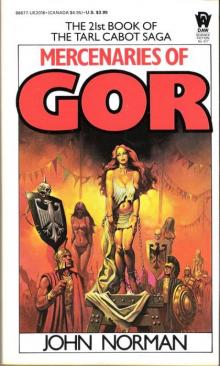 Mercenaries of Gor coc-21
Mercenaries of Gor coc-21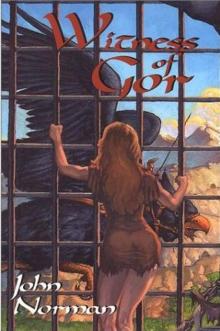 Witness of Gor coc-26
Witness of Gor coc-26 Witness of Gor
Witness of Gor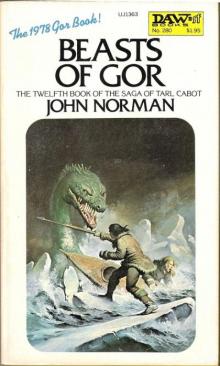 Beasts of Gor coc-12
Beasts of Gor coc-12 Rebels of Gor
Rebels of Gor Mariners of Gor cog[oc-30
Mariners of Gor cog[oc-30 The King th-3
The King th-3 Captive of Gor coc-7
Captive of Gor coc-7 The Captain th-2
The Captain th-2 Vagabonds of Gor coc-24
Vagabonds of Gor coc-24 Explorers of Gor
Explorers of Gor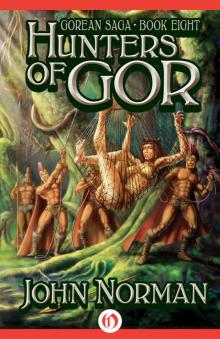 Hunters of Gor
Hunters of Gor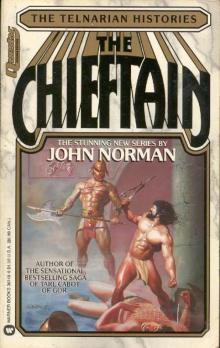 The Chieftan th-1
The Chieftan th-1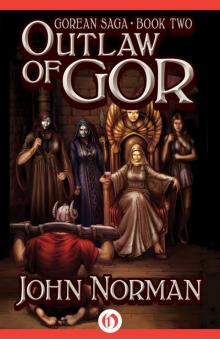 Outlaw of Gor
Outlaw of Gor Priest-Kings of Gor coc-3
Priest-Kings of Gor coc-3 Norman Invasions
Norman Invasions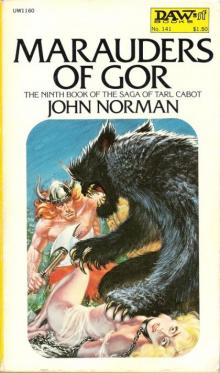 Marauders of Gor coc-9
Marauders of Gor coc-9 Kur of Gor coc-28
Kur of Gor coc-28 Time Slave
Time Slave The Chieftain
The Chieftain Kur of Gor
Kur of Gor Rogue of Gor
Rogue of Gor The Totems of Abydos
The Totems of Abydos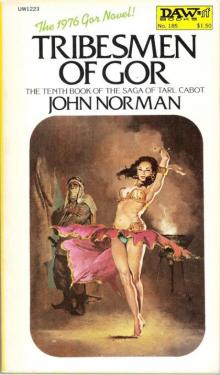 Tribesmen of Gor coc-10
Tribesmen of Gor coc-10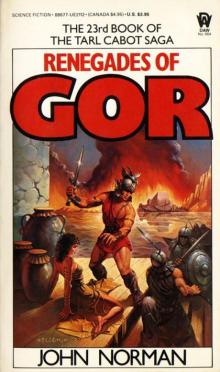 Renegades of Gor coc-23
Renegades of Gor coc-23 The King
The King Tarnsman of Gor
Tarnsman of Gor The Usurper
The Usurper Captive of Gor
Captive of Gor Conspirators of Gor
Conspirators of Gor Smugglers of Gor
Smugglers of Gor Savages of Gor
Savages of Gor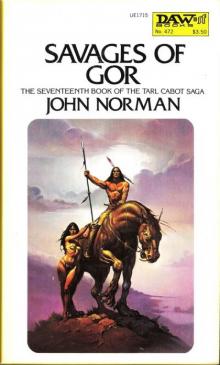 Savages of Gor coc-17
Savages of Gor coc-17 Fighting Slave of Gor
Fighting Slave of Gor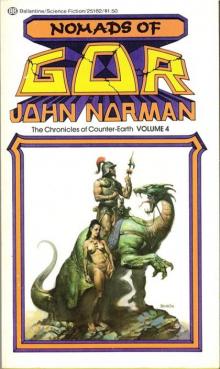 Nomads of Gor coc-4
Nomads of Gor coc-4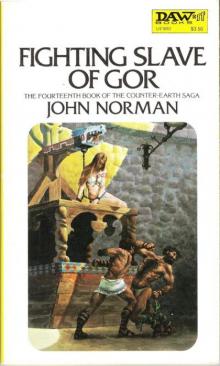 Fighting Slave of Gor coc-14
Fighting Slave of Gor coc-14 Swordsmen of Gor cog[oc-29
Swordsmen of Gor cog[oc-29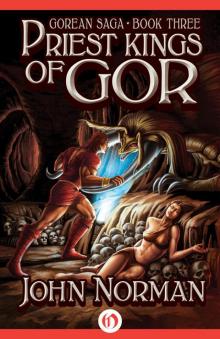 Priest-Kings of Gor
Priest-Kings of Gor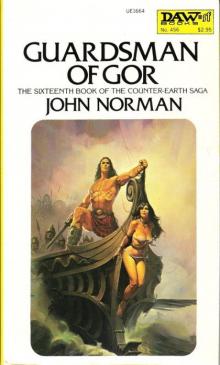 Guardsman of Gor coc-16
Guardsman of Gor coc-16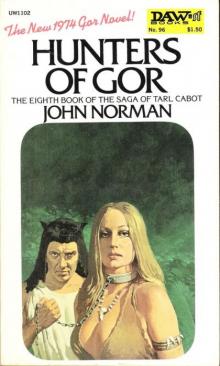 Hunters of Gor coc-8
Hunters of Gor coc-8 Dancer of Gor coc-22
Dancer of Gor coc-22 Prize of Gor coc-27
Prize of Gor coc-27 Conspirators of Gor cog[oc-31
Conspirators of Gor cog[oc-31 Slave Girl of Gor
Slave Girl of Gor Explorers of Gor coc-13
Explorers of Gor coc-13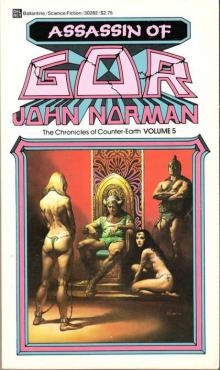 Assassin of Gor coc-5
Assassin of Gor coc-5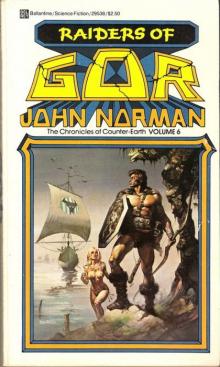 Raiders of Gor coc-6
Raiders of Gor coc-6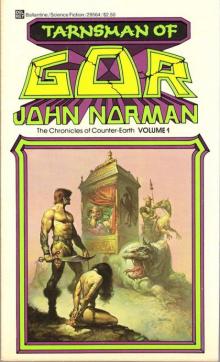 Tarnsman of Gor coc-1
Tarnsman of Gor coc-1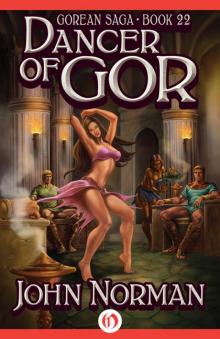 Dancer of Gor
Dancer of Gor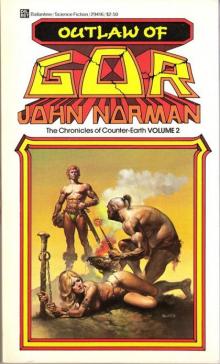 Outlaw of Gor coc-2
Outlaw of Gor coc-2 Guardsman of Gor
Guardsman of Gor Beasts of Gor
Beasts of Gor Ghost Dance
Ghost Dance Nomads of Gor
Nomads of Gor Prize of Gor
Prize of Gor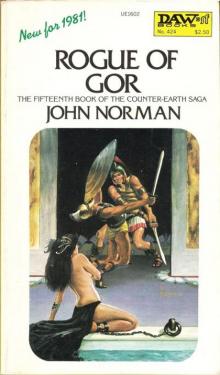 Rogue of Gor coc-15
Rogue of Gor coc-15 Swordsmen of Gor
Swordsmen of Gor